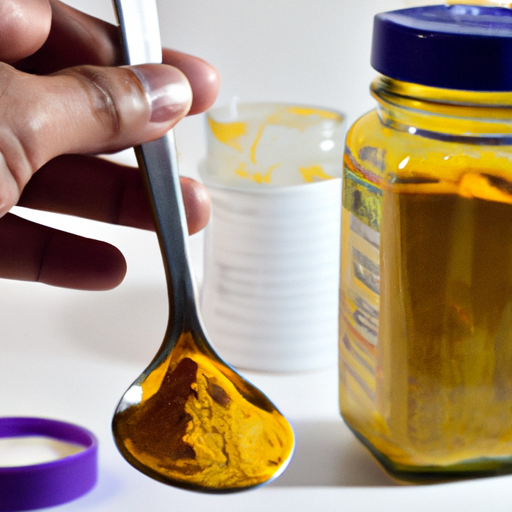As a person who experiences joint pain, I sympathize with how challenging it can be to seek relief. Despite the abundance of medications and treatments out there, I have consistently been drawn to natural remedies.
One such remedy that has gained popularity in recent years is turmeric. But how much turmeric should I take for joint pain? In this article, I will explore the benefits of turmeric and its active ingredient, curcumin, and provide evidence-based recommendations for daily intake to help alleviate joint pain.
Turmeric has been used for centuries in traditional Ayurvedic and Chinese medicine for its anti-inflammatory and antioxidant properties. It is a yellow spice that is commonly used in Indian and Middle Eastern cuisine, and can be found in supplement form as well.
Curcumin is the active ingredient in turmeric that is responsible for its many health benefits, including the ability to reduce inflammation and pain. While turmeric has been touted as a natural remedy for a variety of ailments, including joint pain, it is important to understand the recommended daily intake of curcumin in order to achieve maximum benefits without any potential risks or side effects.
Key Takeaways
- A dosage of 500-2,000 mg of curcumin per day is generally safe and effective for joint pain relief.
- Taking curcumin with black pepper or a meal that contains healthy fats can increase absorption.
- Starting with a low dose of turmeric and gradually increasing the amount over time can help avoid potential side effects.
- Consulting with a healthcare professional is important to ensure safe and effective use of turmeric supplements, especially if taking prescription medications.
Understanding Turmeric and Its Benefits for Joint Pain
If you’re looking to alleviate joint pain, turmeric is a fantastic natural remedy that you should definitely consider incorporating into your daily routine! Turmeric supplements have been used for centuries as alternative remedies for various health conditions, including arthritis and joint pain.
Turmeric contains a powerful compound called curcumin, which is known for its anti-inflammatory properties and ability to reduce pain and swelling in the body. Curcumin is the active ingredient in turmeric that is responsible for its therapeutic effects.
It works by blocking inflammatory pathways and reducing the production of enzymes that cause inflammation in the body. This makes it an effective natural remedy for joint pain, as it can help to reduce inflammation and swelling in the joints.
In the next section, we’ll take a closer look at the role of curcumin in turmeric and how it can help to alleviate joint pain.
The Role of Curcumin in Turmeric
Curcumin, a compound found in turmeric, has been extensively studied for its anti-inflammatory properties and potential benefits for those with joint issues. However, it’s important to note that curcumin absorption is low and that the bioavailability of curcumin can be improved through various methods such as consuming it with black pepper or taking supplements that contain piperine.
To maximize the potential benefits of curcumin for joint pain, it’s important to consider the following:
- The dosage and form of curcumin supplements, as some may be more effective than others.
- The timing of when curcumin is consumed, as taking it with meals or certain types of food may enhance absorption.
- The overall diet and lifestyle practices, as these can also impact the bioavailability of curcumin and overall joint health.
With this in mind, it’s important to consult with a healthcare professional before starting any new supplement regimen.
In the next section, I’ll discuss the recommended daily intake of curcumin for joint pain.
Recommended Daily Intake of Curcumin for Joint Pain
You’ll want to know how much of curcumin to include in your daily routine to experience the benefits it has to offer for joint pain relief. First, it’s important to note that curcumin is the active compound found in turmeric that has anti-inflammatory properties. However, the bioavailability of curcumin is low, meaning that it’s not easily absorbed by the body.
To ensure that you’re getting the most out of your curcumin intake, it’s recommended to take a supplement that contains a higher concentration of curcumin. A dosage of 500-2,000 mg per day is generally safe and effective for joint pain relief. Additionally, taking curcumin with black pepper or a meal that contains healthy fats can increase absorption. It’s also important to note that the best time to take turmeric is with a meal to aid in digestion and absorption.
Moving forward, it’s important to be aware of the potential risks and side effects of consuming turmeric.
Potential Risks and Side Effects of Consuming Turmeric
It’s important to note the potential risks and side effects of consuming turmeric, particularly in large quantities or for extended periods of time. While turmeric is generally considered safe when used in culinary amounts, taking high doses or using turmeric supplements can cause gastrointestinal issues such as nausea, diarrhea, and stomach cramps.
Additionally, some individuals may experience allergic reactions to turmeric, especially if they have a history of allergies to plants in the ginger family.
It’s also important to be aware of the potential interaction between turmeric and certain medications. Turmeric can interfere with the absorption of some drugs, such as blood thinners and diabetes medications, which can lead to negative health consequences.
For this reason, it’s important to consult with a healthcare professional before incorporating turmeric supplements into your diet, particularly if you are taking any prescription medications. By doing so, you can receive personalized dosage advice and ensure that you are using turmeric safely and effectively for your health needs.
Consulting with a Healthcare Professional
When considering turmeric as a supplement for joint pain relief, it’s important to consult with a healthcare professional.
This will allow for an open discussion about any potential risks or interactions with other medications.
Additionally, a healthcare professional can advise on the appropriate dosage and method of consumption based on individual medical history and needs.
Discussing Your Medical History
Just like a car mechanic needs to know the history of your vehicle to diagnose issues, your doctor needs to know your medical history to determine the appropriate turmeric dosage for your joint pain. Your medical background and health conditions can significantly affect how your body will react to turmeric.
For instance, if you’re taking blood-thinning medications, you may need to avoid turmeric supplements as it can also act as a blood thinner. Similarly, if you have gallbladder issues, turmeric may exacerbate your condition.
It’s crucial to be completely honest with your healthcare provider about your medical history to ensure you receive the right advice on dosage and consumption. Your doctor can help determine the best form of turmeric for your needs, such as a supplement or incorporating it into your diet.
By discussing your medical history and current medications with your doctor, you can avoid any adverse effects and make an informed decision about incorporating turmeric into your pain management routine.
Getting Advice on Dosage and Consumption
As we discussed earlier, it’s important to disclose your medical history to your healthcare provider before taking any new supplement, including turmeric. Once you’ve received the green light, it’s important to get advice on dosage and consumption to ensure you’re taking turmeric safely and effectively for your joint pain.
Here are three important pieces of advice to keep in mind when it comes to taking turmeric for joint pain:
-
Start with a low dose: It’s always best to start with a lower dose of turmeric and gradually increase the amount over time. This will help you determine how much turmeric your body can handle and avoid any potential side effects.
-
Choose high-quality supplements: When choosing a turmeric supplement, look for products that are certified by a reputable organization. This will ensure that you’re getting a high-quality supplement that’s safe and effective.
-
Incorporate turmeric into your diet: In addition to taking turmeric supplements, you can also incorporate turmeric into your diet by adding it to your meals. This can include adding turmeric to smoothies, soups, and curries.
By following these dosage advice and consumption tips, you can safely and effectively incorporate turmeric into your joint pain management plan.
In the next section, we’ll discuss how to incorporate turmeric into your diet in more detail.
Incorporating Turmeric into Your Diet
I’ve found that incorporating turmeric into my diet has been a great way to reap the benefits of this powerful spice. One way I like to use turmeric is by adding the powder to my cooking, which not only adds flavor but also provides anti-inflammatory properties.
Additionally, I’ve started drinking turmeric tea, which is a soothing way to consume this spice. And for those who may not enjoy the taste of turmeric, there are also supplement options available to ensure you’re getting enough of this beneficial ingredient.
Using Turmeric Powder in Cooking
You’ll be delighted to know that using turmeric powder in your cooking not only adds a warm, earthy flavor to your dishes but also provides potential joint pain relief. Here are some cooking tips and flavor combinations that can help you reap the benefits of turmeric:
- Add a pinch of turmeric powder to your scrambled eggs or omelets for a vibrant yellow color and a hint of flavor.
- Mix turmeric powder with olive oil, garlic, and lemon juice for a delicious marinade for chicken or fish.
- Sprinkle turmeric powder on roasted vegetables such as cauliflower, sweet potatoes, or Brussels sprouts for an extra boost of flavor and health benefits.
Incorporating turmeric powder into your cooking is just one way to enjoy its potential health benefits. Another option is drinking turmeric tea, which we’ll discuss in the next section.
Drinking Turmeric Tea
Sipping on a cup of golden tea infused with the warm and earthy spice can provide potential health benefits. Turmeric tea has been used for centuries in traditional Indian medicine to treat a variety of ailments, including joint pain.
Turmeric contains a compound called curcumin that has anti-inflammatory properties, which can help reduce inflammation and pain in the joints. Turmeric tea benefits can be maximized by brewing it properly.
To make a turmeric tea, add one teaspoon of turmeric powder to two cups of water and bring it to a boil. Simmer for 10 minutes, strain, and add honey or lemon to taste. For a more indulgent treat, try a turmeric latte recipe by adding a dash of cinnamon, ginger, and nutmeg to the mix.
While turmeric tea can be a great addition to any wellness routine, it’s important to note that it may not provide the same level of benefits as turmeric supplements.
Taking Turmeric Supplements
If you’re looking for a way to potentially boost your overall health, turmeric supplements might be worth considering. Turmeric, a spice commonly used in Indian cuisine, contains a compound called curcumin which has been found to have anti-inflammatory and antioxidant properties. This makes it a popular natural remedy for joint pain, among other health conditions.
When it comes to turmeric dosage, it is important to note that there is no one-size-fits-all recommendation. The amount of turmeric you should take for joint pain may vary depending on factors such as your age, weight, and overall health. However, a general guideline is to aim for 500-2000mg of curcumin per day. To give you a better idea, here is a table showing the amount of curcumin in various turmeric supplements:
| Supplement | Curcumin Content per Serving |
|---|---|
| Powdered Turmeric | 3.14mg-6.6mg |
| Turmeric Capsules | 95mg-150mg |
| Curcumin Supplements | 400mg-600mg |
While turmeric has potential benefits for joint pain and overall health, it is important to consult with your healthcare provider before taking any new supplements. Additionally, combining turmeric with other natural remedies such as ginger and black pepper may also enhance its effects.
Combining Turmeric with Other Natural Remedies
I’ve found that combining turmeric with other natural remedies can be an effective way to alleviate joint pain.
One such combination that I’ve tried is turmeric and ginger. This combination has been shown to have anti-inflammatory properties.
Additionally, adding black pepper to turmeric can enhance its absorption and effectiveness in the body.
Ginger and Turmeric
You can easily incorporate ginger and turmeric into your diet to help alleviate joint pain. Both of these natural remedies have anti-inflammatory properties that can reduce swelling and discomfort in the joints. Additionally, ginger and turmeric have various other health benefits that can improve your overall well-being.
Here are some of the benefits of ginger and turmeric for digestion, as well as some turmeric latte recipes to try:
-
Ginger has been shown to improve digestion by increasing the production of digestive enzymes and reducing inflammation in the gut. You can add fresh ginger to smoothies, stir-fries, or teas for a spicy kick.
-
Turmeric can also aid digestion by stimulating the production of bile, which helps break down fats. Try adding turmeric to soups, curries, or golden milk lattes for a warming and flavorful addition to your meals.
To make a turmeric latte, simply mix together 1 teaspoon of turmeric powder, 1/2 teaspoon of cinnamon, 1/2 teaspoon of ginger powder, and a dash of black pepper in a saucepan with 2 cups of milk (dairy or non-dairy). Heat the mixture over medium heat until warmed through, then pour into a mug and enjoy!
By incorporating ginger and turmeric into your diet, you can not only help relieve joint pain but also improve your digestive health. Next, let’s discuss how black pepper can enhance the benefits of turmeric even further.
Turmeric and Black Pepper
Now, let’s explore how adding black pepper to turmeric can enhance its health benefits and improve your overall well-being.
Turmeric and black pepper are a great combination as they work together to increase the bioavailability of curcumin, the active component in turmeric. Black pepper contains a compound called piperine that helps to boost the absorption of curcumin by up to 2,000%. This means that by adding black pepper to turmeric, you can increase its effectiveness in reducing inflammation and joint pain.
In addition to improving absorption, turmeric and black pepper also have individual health benefits. Turmeric has anti-inflammatory and antioxidant properties, while black pepper has antibacterial and anti-inflammatory effects. Together, they can help to reduce inflammation, improve digestion, boost brain function, and even lower the risk of cancer.
To enjoy the benefits of this powerful combination, try adding a pinch of black pepper to your turmeric tea or golden milk recipe. You can also use this spice blend in your cooking to add flavor and nutrition to your meals.
As you can see, turmeric and black pepper are a great combination for reducing joint pain and improving overall health. However, there are also other lifestyle changes that you can make to reduce joint pain, such as maintaining a healthy weight, doing regular exercise, and eating a balanced diet. Let’s explore these further in the next section.
Lifestyle Changes to Reduce Joint Pain
I’ve found that making lifestyle changes can greatly reduce my joint pain. Maintaining a healthy weight has been especially important for me. Regular exercise not only helps me manage my weight, but it also strengthens my joints.
Finally, managing stress through techniques like meditation or yoga has also been helpful in reducing my joint pain. These are evidence-based strategies that anyone can implement to improve their joint health.
Maintaining a Healthy Weight
Maintaining a healthy weight is important because it can help ease joint pain. One way to achieve this is by practicing healthy eating habits and engaging in physical activity.
Eating a well-balanced diet that includes fruits, vegetables, lean proteins, and whole grains can provide the necessary nutrients to support joint health. It’s also important to avoid processed foods, sugary drinks, and excessive amounts of saturated and trans fats, as these can contribute to inflammation in the body.
Physical activity is crucial for maintaining a healthy weight and reducing joint pain. Low-impact exercises like swimming, biking, and yoga can help improve flexibility and strengthen the muscles around the joints. Doing these exercises regularly can also promote weight loss and improve overall cardiovascular health.
By incorporating healthy eating habits and physical activity into your lifestyle, you can maintain a healthy weight and reduce the risk of joint pain. As a result, you can move on to the subsequent section about ‘exercising regularly’ with a solid foundation to build upon.
Exercising Regularly
To keep my joints healthy and strong, I make exercising regularly a part of my daily routine. Consistency is key when it comes to maintaining joint health, so I try to exercise at least 30 minutes a day, five times a week.
I find that breaking up my exercise routine into manageable chunks throughout the day helps me stay on track and ensures that I meet my daily exercise goals. To make exercising enjoyable, I try to incorporate a variety of different activities into my routine.
I love going for walks outside, doing yoga, and lifting weights at the gym. By mixing up my activities, I never get bored and I am able to target different muscle groups, which helps me strengthen my joints and prevent injury.
As I move into the next section on managing stress, I know that exercise will continue to play an important role in keeping my body and mind healthy.
Managing Stress
Managing stress is like taking a deep breath of fresh air after being cooped up in a stuffy room all day. It is essential to manage stress because it can lead to various health problems, including joint pain. Relaxation techniques such as deep breathing, meditation, yoga, and progressive muscle relaxation have shown to be effective in reducing stress and managing pain.
Mindfulness practice is a technique that involves being present in the moment and observing thoughts and feelings without judgment. It has been found useful in reducing stress and improving overall well-being. Practicing mindfulness involves focusing on the present moment and being aware of one’s thoughts and surroundings. By doing so, one can learn to manage stressors better and reduce the impact they have on their physical and emotional health.
Transitioning into the subsequent section about other alternative treatments for joint pain, incorporating relaxation techniques and mindfulness practice can be helpful, but there are other options available as well.
Other Alternative Treatments for Joint Pain
You can explore other natural remedies to ease joint pain, such as acupuncture, massage therapy, and herbal supplements. These holistic approaches can help reduce inflammation, improve circulation, and promote relaxation.
Acupuncture involves inserting thin needles into specific points on the body to stimulate the flow of energy and alleviate pain. It’s been shown to be effective in reducing joint pain and stiffness in people with osteoarthritis and rheumatoid arthritis.
Massage therapy can also be beneficial for joint pain. It can help reduce muscle tension, improve circulation, and promote relaxation. A study published in the Journal of General Internal Medicine found that massage therapy significantly improved pain, stiffness, and physical function in people with osteoarthritis of the knee.
In addition, certain herbal supplements, such as ginger and turmeric, have anti-inflammatory properties that may help reduce joint pain. However, it’s important to talk to your doctor before taking any new supplements to make sure they’re safe for you to use.
Frequently Asked Questions
Can turmeric be used to treat joint pain in children?
Oh, sure. Let’s give our kids turmeric for joint pain relief. Because who needs actual medical treatment? But if you insist, the recommended turmeric dosage for pediatric joint health is 400-600mg, twice daily.
How long does it take for turmeric to start relieving joint pain?
I have found that the timeframe for relief when taking turmeric for joint pain can vary. Some people report feeling benefits within a few days, while others may need to take it consistently for several weeks. It is important to consult with a healthcare provider for proper turmeric dosage.
Can turmeric supplements interact with medications for other health conditions?
I liken taking turmeric supplements to driving a car. While it can be a smooth ride, it’s important to know if it can interact with other medications for your safety. Always consult with a healthcare provider before combining with other natural remedies for joint pain relief.
Is it possible to consume too much turmeric and experience negative side effects?
Yes, it’s possible to consume too much turmeric and experience negative side effects. Turmeric overdose may cause gastrointestinal issues, liver damage, and allergic reactions. Always follow the recommended dosage and consult a healthcare professional.
Are there any specific types or brands of turmeric that are more effective for joint pain relief?
When it comes to turmeric types, there are many options that claim to provide joint pain relief. However, it’s important to research their effectiveness and potential negative side effects. Consult with a healthcare professional about dosage amount, medication interaction, and whether it’s safe for children. Results may vary and take time to see improvement.
Conclusion
So, how much turmeric should I take for joint pain? After researching the benefits and risks of consuming turmeric, it’s recommended to take 500-2,000mg of curcumin daily to help reduce joint pain and inflammation.
It’s important to note that consuming too much turmeric may lead to side effects such as stomach upset, nausea, and diarrhea. Therefore, it’s crucial to consult with a healthcare professional before incorporating turmeric into your diet.
Incorporating turmeric into your daily routine can be as simple as adding it to your meals or taking it in supplement form. However, it’s important to remember that turmeric is not a cure-all for joint pain and should be used in conjunction with other lifestyle changes such as exercise and a healthy diet.
Overall, turmeric is a natural and effective remedy for joint pain and can provide significant relief when used in moderation and under the guidance of a healthcare professional. Remember, a little turmeric can go a long way in improving your joint health!










